|
|
REVIEW OF THE BIRDS IN THE LOWESTOFT AREA
JANUARY - JUNE 2001
by Robert Wilton

Snow Buntings, Plectrophenax
nivalis, Kessingland Beach.
IF ONE THING CAN BE LEARNT FROM JANUARY 2001, it is what a good place Carlton Marshes is. The undisputed highlight was a WILLOW TIT, Parus montanus, associating with a Long-tailed Tit, Aegithalos caudatus, flock at Sprat's Water, on the 24th and 27th. This species used to breed sparsely around Lowestoft in the late 1970s but rapidly became local rarities. The last reliable pair used to come to a bird feeder, up until the mid-1990s, at Fisher Row. As this is only a short distance north of Carlton Marshes, it may be a sign that they are just about clinging on in the area. Fingers crossed they stage a comeback.
Close scrutiny of the gull roost at Burnt Hill Lane, Carlton Colville was rewarded with two regular adult CASPIAN GULLS, Larus cachinnans, three adult Mediterranean Gulls, L. melanocephalus, and a third winter Yellow-legged Gull, L. michahellis. Up to three very obliging Short-eared Owls, Asio flammeus, could be seen quartering the marshes all month from mid-afternoon until dusk and a Barn Owl, Tyto alba, was seen from the visitor centre most evenings.
Haddiscoe Marshes was once again 'the place' to see raptors, the highlight being a ROUGH-LEGGED BUZZARD, Buteo lagopus. With so few in Britain at the time it was widely twitched. The supporting cast included up to four Marsh and two Hen Harriers, two Peregrine Falcons, Falco peregrinus, two Barn and two Short-eared Owls.
The long staying GREAT NORTHERN DIVER, Gavia immer, remained on Lake Lothing, Lowestoft, throughout as did two handsome drake Red-breasted Mergansers, Mergus serrator, and at least one Shag, Phalacrocorax aristotelis. A winter plumaged Guillemot, Uria aalge, was seen on a couple of dates and two female Eiders, Somateria mollissima, frequented Hamilton Dock, Lowestoft Harbour.
At Ness Point six Rock Pipits, Anthus petrosus, ranged between the jetty and the South Pier and three Black Redstarts, Phoenicurus ochrurus, seen regularly between the Harbour and Ness Point itself included a stunning male. Offshore three adult Mediterranean Gulls and an unseasonal adult Little Gull, L. minutus, fed at the sewage outfall, on the 14th. Recently, a large section of the North Beach has been scoured away by the sea, exposing much more of the old seawall than usual. At low tide the Purple Sandpipers, Calidris maritima, favoured this area where 8 on the 8th was the maximum count.
Extremely high water levels at Leathe’s Ham, Lowestoft, resulted in the local Water Rails being fairly easy to see as they fed along the edge of the car park; and at Lound Waterworks the Barnacle Goose, Branta leucopsis, flock peaked at 302 on the 14th, apparently a new site record.
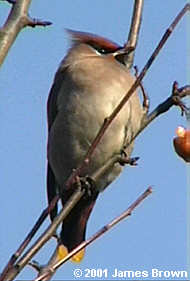 Bohemian
Waxwings, Bombycilla garrulus,
were seen in small numbers at Great Yarmouth, Gorleston, St. Olaves, Oulton
Broad, Lowestoft and Kessingland. Pictured left is one seen at Oulton Broad
North Railway Station. 40-45 Snow Buntings commuted between
Kessingland Sluice and Pakefield Riffle Range all month. Chiffchaffs, Phylloscopus
collybita, were at Kessingland Sewage Works, Breydon Way and Stevens/Clemence
Street, Lowestoft. However, the only Blackcap, Sylvia atricapilla,
reported was a male in gardens along Holly Road, Oulton Broad, on the 7th.
Bohemian
Waxwings, Bombycilla garrulus,
were seen in small numbers at Great Yarmouth, Gorleston, St. Olaves, Oulton
Broad, Lowestoft and Kessingland. Pictured left is one seen at Oulton Broad
North Railway Station. 40-45 Snow Buntings commuted between
Kessingland Sluice and Pakefield Riffle Range all month. Chiffchaffs, Phylloscopus
collybita, were at Kessingland Sewage Works, Breydon Way and Stevens/Clemence
Street, Lowestoft. However, the only Blackcap, Sylvia atricapilla,
reported was a male in gardens along Holly Road, Oulton Broad, on the 7th.
After a good showing in December the only report of a Skua was an Arctic, Stercorarius parasiticus, flying south over Kessingland Beach on the 2nd. This particular bird had an injured leg and had been at Sizewell the previous day.
Finally with 'Ole Frank' being the local name for Grey Heron, Ardea cinerea, could there have been a more appropriate location in Lowestoft to have seen one fly over than the Ole Frank pub itself?
FEBRUARY was relatively quiet but interesting none the less. The GREAT NORTHERN DIVER was on Lake Lothing throughout and was joined by a colour ringed Great Cormorant, Phalacrocorax carbo, on the 17th. This bird had been ringed on the Friesian island of Vlieland, Holland on June 8th, 1999 where it was still present in the ground-nesting colony on July 16th. By September 14th, it had flown to Lowestoft where it was last seen on April 29th, 2000.
The ROUGH-LEGGED BUZZARD was the star raptor in the Haddiscoe Marshes area throughout. The supporting cast was again impressive and included two Barn and one Short-eared Owl, several Marsh and Hen Harriers, a Common Buzzard, B. buteo, three Peregrine Falcons and a Merlin, F. columbarius. The flooded marshland there was particularly productive. Peak counts and highlights were: 200+ Eurasian Wigeon, Anas penelope, 20 Gadwall, A. strepera, 150 Eurasian Teal, A. crecca, 16 Northern Pintail A. acuta, 1500 Lapwing, Vanellus vanellus, LITTLE STINT, C. minuta, GREEN SANDPIPER, Tringa ochropus, 50+ Common Snipe, Gallinago gallinago, 12 RUFF, Philomachus pugnax, 300 Black-tailed Godwits, Limosa limosa.
At Ness Point Purple Sandpiper numbers increased from 8 in January to 12, which remained all month. 86 Turnstone, Arenaria interpres, roosted on the rocks at Lowestoft’s South Pier on the 17th, but Sanderling, Calidris alba, numbers were well down on previous winters with 6 being the maximum count. A Woodcock, Scolopax rusticola, which was flushed from the tideline rocks at the Old Coastguard Station, Lowestoft, on the 5th was presumably a new arrival.
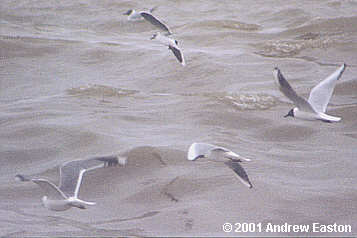 Mediterranean
Gulls were around in
good numbers this month. At least five adults were between Lowestoft Harbour
and North Denes on the 17th. One of which was displaying to Black-headed
Gulls, L. ridibundus, with no success! Elsewhere, an adult and
second-winter were on Haddiscoe Marshes on the 19th and an adult was at Burnt
Hill Lane, Carlton Colville on the 3rd.
Mediterranean
Gulls were around in
good numbers this month. At least five adults were between Lowestoft Harbour
and North Denes on the 17th. One of which was displaying to Black-headed
Gulls, L. ridibundus, with no success! Elsewhere, an adult and
second-winter were on Haddiscoe Marshes on the 19th and an adult was at Burnt
Hill Lane, Carlton Colville on the 3rd.
Single adult Little Gulls were attracted to Ness Point sewage outfall on a couple of dates and on the 4th, 11 flew south with two others lingering. The regular adult is at the top middle of the photo to the right, at the lower left is a Common Gull, L. canus, and to the lower right two Black-headed Gulls, L. ridibundus. The only other notable sighting offshore was 350 Red-throated Divers, Gavia stellata, at Ness Point on the 24th.
The passerines that were around were much sought after. Non-more so than the pair of Black Redstarts that frequented Hamilton Road and five Bohemian Waxwings, at Bloodmoor Road, Lowestoft, on the 3rd. Another flock of Bohemian Waxwings, 23 this time, were seen at the Rainbow superstore, Carlton Colville on the 26th. Wintering Chiffchaffs were seen in gardens in south Lowestoft and Hopton and two were at Kessingland Sewage Works on the 14th, and a male Blackcap was in gardens in Oulton village during the last two weeks of the month. A flock of up to 38 Snow Buntings at Kessingland Beach included some stunning males.
Maritime matters dominated local birding during MARCH with most 'Lizards' making a weekend pilgrimage to Ness Point. The sewage outfall has been shut all year while a new, multi million pound, sewage treatment plant is being built at Corton and Ness Point. This has resultd in the gulls feeding close inshore. It was therefore surprising that the avian highlight of the month was a passerine instead of a rare gull. Easterly winds and overnight fog on the 23rd resulted in spring migration getting off to a flyer on the 24th. A small arrival of migrants was headlined by a superb male WHITE-SPOTTED BLUETHROAT, Luscinia svecica cyanecula. To read a report of this bird click here. Other migrants in the Lowestoft area at same time included 10 Northern Wheatears, Oenanthe oenanthe, 2 Firecrests, Regulus ignicapillus, and a Brambling, Fringilla montifringilla.
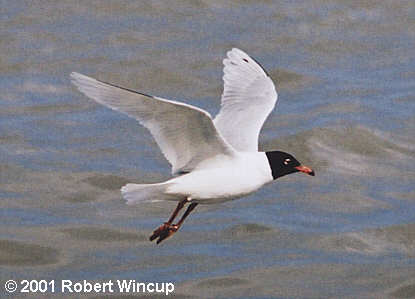 Occasional
Fulmar and good numbers of northbound Gannets were also recorded
at Ness Point during March. The vast majority of the Gannets were adults and
some of them were probably heading for the large colony at Bass Rock, Scotland,
the source of the species scientific name, Morus bassanus. An adult
Little Gull was, more or less, a permanent fixture at the sewage outfall
and as many as 10 adult Mediterranean Gulls were seen. Numbers of the
latter peaked mid-month, decreasing thereafter coinciding with reports that
the first adults were arriving back at their breeding colonies in Belgium
among other places. Surprisingly only one first-year bird was seen. The breeding
plumaged bird pictured left, with two small black spots on the primaries,
is probably a third summer bird rather than full adult. Though it could possibly
be a second summer bird with very reduced black markings. Whatever its age
it was a very smart bird.
Occasional
Fulmar and good numbers of northbound Gannets were also recorded
at Ness Point during March. The vast majority of the Gannets were adults and
some of them were probably heading for the large colony at Bass Rock, Scotland,
the source of the species scientific name, Morus bassanus. An adult
Little Gull was, more or less, a permanent fixture at the sewage outfall
and as many as 10 adult Mediterranean Gulls were seen. Numbers of the
latter peaked mid-month, decreasing thereafter coinciding with reports that
the first adults were arriving back at their breeding colonies in Belgium
among other places. Surprisingly only one first-year bird was seen. The breeding
plumaged bird pictured left, with two small black spots on the primaries,
is probably a third summer bird rather than full adult. Though it could possibly
be a second summer bird with very reduced black markings. Whatever its age
it was a very smart bird.
The wintering Shag with a plastic leg ring, (inscription JIA), was seen to go to roost on the Kittiwake wall on a couple of dates. This particular bird was colour ringed as a nestling on the Isle of May, Fife, Scotland on July 28, 1999 and was previously seen in Lowestoft between April 8th and May 9th, 2000.
Good numbers of Red-throated Divers were recorded offshore early in the month and on the 4th a BLACK-THROATED was close inshore at Pakefield. With the GREAT NORTHERN remaining on Lake Lothing all month the diver hat trick was achieved. The winters other long staying bird, the ROUGH-LEGGED BUZZARD was seen almost daily in the Haddiscoe Marshes area and a Common Buzzard arrived in off the sea at Corton on the 27th.
A drake Red-breasted Merganser, Mergus serrator, which had been present on Lake Lothing for some time was on Oulton Broad on the 10th and was sadly, slightly oiled. A male Common Eider, Somateria mollissima, on the sea off Lowestoft South Pier on the 15th was in better health.
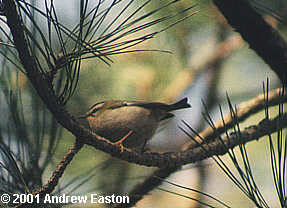 A
flock of 30 Bohemian Waxwing was in Bell Lane, Belton, on the 27th.
Towards the end of the month several departing Redwings, Turdus
iliacus, were heard calling as they passed over the town at night. Many
birds were on the move on the 31st. Most noticeable was the continuous southbound
passage of Linnets, Carduelis cannabina, totalling at least
300 birds. The first Swallow, Sand Martins, and Blackcap
were also noted around this date. After initial sightings from Flycatcher
Lane and Warrenhouse Wood a minimum of 10 Firecrests were recorded
and up to 30 Chiffchaffs were at coastal locations. The number of Firecrests
is particularly significant as they are normally quite scarce in spring locally.
One of the Kensington Gardens Firecrests is pictured to the right.
A
flock of 30 Bohemian Waxwing was in Bell Lane, Belton, on the 27th.
Towards the end of the month several departing Redwings, Turdus
iliacus, were heard calling as they passed over the town at night. Many
birds were on the move on the 31st. Most noticeable was the continuous southbound
passage of Linnets, Carduelis cannabina, totalling at least
300 birds. The first Swallow, Sand Martins, and Blackcap
were also noted around this date. After initial sightings from Flycatcher
Lane and Warrenhouse Wood a minimum of 10 Firecrests were recorded
and up to 30 Chiffchaffs were at coastal locations. The number of Firecrests
is particularly significant as they are normally quite scarce in spring locally.
One of the Kensington Gardens Firecrests is pictured to the right.
Butterflies
were also on the wing in the last week of the month, the warm weather tempting
many Small Tortoiseshell and Peacock, with lesser numbers of Comma and one
Red Admiral out of hibernation, spring had arrived, or so we thought!!!
Once again Ness Point produced the Lion's share of avian activity during APRIL. Good numbers of Gannets were noted on several days early in the month and peaked on the 21st. After a couple of days of strong northerly winds an amazing total of 1,800 plus were seen. As in all previous cases this spring almost all were adults. This count is a new Suffolk record easily surpassing the previous day total of 560 at Covehithe on April 16th, 1994.
A continuous northward passage of Fulmars and Kittiwakes, Rissa tridactyla, was also evident throughout the day with other notable nauticals including the years second GREAT NORTHERN DIVER, nine Red-throated Divers, one MANX SHEARWATER, 15 Sandwich, one Common, S. hirundo and one Arctic Tern, S. paradisaea, three GREAT, Stercorarius skua, six Arctic, S. parasiticus and one POMARINE SKUA, S. pomarinus. Of the ten skuas seen only the 'Pom' appeared to linger being seen in the morning and afternoon, harrying gulls on both occasions. All in all this was a far better seawatch than we are usually treated too in a good autumn!!!
On the
22nd a further 4 MANX SHEARWATERS, Puffinus puffinus, flew north past
Ness Point, good birds at any time of year in Lowestoft. A first summer POMARINE
SKUA was watched for 20 minutes off Corton Cliffs on the 13th harrying
gulls which were following a small fishing vessel heading towards Yarmouth
Harbour. Several Fulmar and 8 Gannets joined the melee of 500+
gulls that swarmed around the boat.
On the 9th a drake Red-breasted Merganser was on the River Waveney near St. Olaves bridge. Perhaps it was the same individual that was seen on Oulton Broad in March. The same observer was treated to a drake Goosander, M. merganser, at the same site on the 12th.
A Common Sandpiper, Actitis hypoleucos, was feeding on the filter beds at Kessingland sewage works on the 30th and the last report of Purple Sandpiper concerned 2 at Ness Point on the 23rd.
The ROUGH-LEGGED BUZZARD was seen at Ashby Dell on the 8th hovering overhead before heading off towards Haddiscoe and one of the only migrant Common Buzzards this spring flew north over Kessingland sewage works on the 1st. Both Barn and Short-eared Owls were quartering marshes on the south shore of Breydon Water until dusk on the 25th.
By the months end many common migrants were passing through in good numbers including Common Swift, Apus apus, House Martin, Delichon urbica, White Wagtail, Motacilla alba alba, Northern Wheatear, Sedge Warbler, Acrocephalus schoenobaenus, Lesser Whitethroat, S. curruca, Whitethroat, S. communis and Blackcap, S. atricapilla. Three Turtle Doves, Streptopelia turtur, arrived in off the sea at 7:30 on the 27th and a Firecrest paid a garden visit to Ash Farm, Mutford near Lowestoft on the 30th.
 The
first BLUE-HEADED WAGTAIL, M. (flava) flava, of the spring was
found at Kessingland sewage works on the 25th and turned out to be the most
interesting. This particular bird (pictured to the left) exhibited characteristics
of the race 'beema' which is commonly referred to as Syke's Wagtial.
Those occuring in Britain are generally regarded as being hybrids resulting
from mixed pairs of Yellow and Blue-headed Wagtails, rather than the real
thing from the steppes of Central Asia, but who's to say that some aren't
the real thing? Several other Blue-head's were seen along with numerous Yellow
Wagtails, M. flava flavissima. The presence of some stunning
male wagtails has been one of the highlights of the spring so far, proving
that not all things have to be rare.
The
first BLUE-HEADED WAGTAIL, M. (flava) flava, of the spring was
found at Kessingland sewage works on the 25th and turned out to be the most
interesting. This particular bird (pictured to the left) exhibited characteristics
of the race 'beema' which is commonly referred to as Syke's Wagtial.
Those occuring in Britain are generally regarded as being hybrids resulting
from mixed pairs of Yellow and Blue-headed Wagtails, rather than the real
thing from the steppes of Central Asia, but who's to say that some aren't
the real thing? Several other Blue-head's were seen along with numerous Yellow
Wagtails, M. flava flavissima. The presence of some stunning
male wagtails has been one of the highlights of the spring so far, proving
that not all things have to be rare.
Bohemian Waxwings continued to be seen up to the months end albeit
in smaller numbers. The last reports came from Myrtle Close and Marham Road
on the 25th.
Some of the best passerines were all too brief and included a stunning male
Pied Flycatcher, Ficedula hypoleuca, at Kessingland sewage works
on the 26th, a HAWFINCH, Coccothraustes coccothraustes, at Gorleston
golf course on the 23rd, a SHORE LARK, Eremophila alpestris,
that flew south over Gunton Dunes, Lowestoft on the 1st, a Tree Pipit,
Anthus trivialis, at the former M.o.D complex, Corton early morning
on the 23rd, a male Whinchat, Saxicola rubetra, in horse paddocks
at Corton on the 30th and a COMMON NIGHTINGALE, Luscinia megarhynchos,
singing in coastal scrub at Pakefield on the 28th. A male Common Redstart,
P. phoenicurus, bucked the trend by staying all day on the 23rd showing
well in the flowerbeds on the Denes Oval, Lowestoft.
Probably the most unexpected bird of the spring concerned a BITTERN,
Botaurus stellaris, which flew south at a height of about 200 feet,
over the North Denes and Ness Point at 11:00am on 8th. You just never know
what to expect!!!
After
the euphoria created by four Bee-eaters, Merops apiaster, and an Alpine
Accentor, Prunella collaris, in the year 2000, this MAY could
have hardly lived up to expectations. With that said this year faired better
for more regular species. Whitethroats, were conspicuous in almost
every patch of scrub. 'Flava' of the month was a male
wagtail showing characteristics of GREY-HEADED, M. f. thunbergi,
which was present on Lowestoft North Denes on the 5th. This birds stay was
brief and it soon flew off south. The 'Sykes' type Yellow Wagtail
continued to show well at Kessingland sewage works unitil the 9th and several
White Wagtails, were noted early on.
On the 13th a MARSH WARBLER, A.
palustris,
was heard in song and seen briefly at Oulton Marshes. Identification was clinched
when a Common Tern, S.
hirundo, started calling
from the centre of a bush! Another was heard and seen very well along Bridge
Road, Gorleston on the 27th. A Sedge Warbler, was also present the
same day. The following day a Reed Warbler, A. scirpaceus, replaced
the departed Marsh.
Terns were moving on the 14th with 100 Common, 9 Little, S.
albifrons, 3 Sandwich, S. sandvicensis, and 2 Arctic,
S. paradisaea, logged past Ness Point. Good numbers of Common Terns
were once again observed on the 15th with 51 resting on a single groyne at
Hopton in the morning. During the evening c100 were seen between Lowestoft
and Corton, with a further 16 on Lowestoft South Beach along with 29 Little
Terns, a notable local record. All three species continued to show well for
the remainder of the month.
A COMMON CRANE, Grus grus, was found feeding in a field west
of the Kessingland bypass on the 13th. The bird was present from 9:15-9:30
and was mainly seen in flight circling low over farmland. Several gulls and
corvids mobbed the bird before it eventually drifted off towards Carlton Colville/Gisleham.
This species was formerly a great rarity in this area but in recent years
one or two records are seen each year a year, normally in the spring. Briefer
still was a male MONTAGU'S HARRIER, Circus pygargus, that flew
west over Oulton Marshes, Lowestoft at 09:50hrs on the 20th. One day there
will be a twitchable one locally!
Firecrests were seen at various places once again, including a male singing its heart out at Corton on the 15th. Other scarce passerines included 2 Nightingales, 3 male Pied Flycatchers, 2 Tree Pipits, a further 3 male Redstart, 2 Whinchat and a very late Bohemian Waxwing in a Beccles garden on the 10th.
The
only record of Spotted Flycatcher, Muscicapa striata, came from
a traditional site in Beccles. Sadly this species has crashed over the last
10 years locally. In stark contrast Cetti's Warblers, Cettia cetti,
are exploding after a series of consecutive mild winters. Three were heard
in Hall Road, Oulton where the third MARSH WARBLER of the spring took
up temporary residence from the 27th-June 1. Unlike the previous two this
bird was twitchable performing extremely well during its stay. As
well as mimicking the usual Swallow, Hirundo rustica, and Goldfinch,
Carduelis carduelis, calls this bird incorporated the calls of Yellow
Wagtail, Motacilla flava, Oystercatcher, Haematopus ostralegus,
and Bee-eater amongst others into its song. One phrase was uncannily like
the loud 'toyt' call of a Nuthatch, Sitta europaea.
And so the month ended on a high note!!!
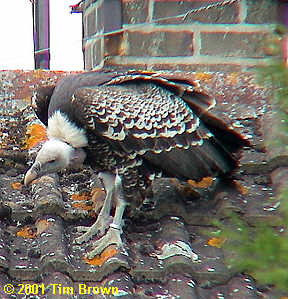 Escapes
headlined JUNE with a Rüppell's Griffon Vulture,
Gyps rueppellii, proving a novelty. Having escaped from Banham
Zoo, near Diss, Norfolk during a falconry display, 'Foster' (pictured to the
right) headed for the Norfolk coast at Happisburgh where he spent a couple
of days before heading south along the coast to the Reydon area, near Southwold,
Suffolk on the 21st to 23rd. He quickly became a media star, with press and
TV cameras following his every move. He was finally recaptured on the 24th.
A Canary, Serinus canaria, in Bevan Street, Lowestoft, on the
24th failed to attract similar interest!
Escapes
headlined JUNE with a Rüppell's Griffon Vulture,
Gyps rueppellii, proving a novelty. Having escaped from Banham
Zoo, near Diss, Norfolk during a falconry display, 'Foster' (pictured to the
right) headed for the Norfolk coast at Happisburgh where he spent a couple
of days before heading south along the coast to the Reydon area, near Southwold,
Suffolk on the 21st to 23rd. He quickly became a media star, with press and
TV cameras following his every move. He was finally recaptured on the 24th.
A Canary, Serinus canaria, in Bevan Street, Lowestoft, on the
24th failed to attract similar interest!
A
WHITE STORK,
Ciconia ciconia, seen flying
east over Haddiscoe/St. Olaves Bridge at 9:00am on the 9th was almost certainly
of dubious origin. The nearby wildlife collection at Thrigby Hall, Norfolk
is a known site where this species has escaped from in the past. Most years
one or two are recorded over the Waveney Valley.
With spring migration over the time came to count some
of the breeding birds. With nice weather on the 23rd a start was made on
the population of large gulls in Lowestoft, namely Herring Gull Larus
argentatus, and Lesser Black-backed Gull, L. fuscus. The
vast majority of both species nest on roofs locally, with the largest concentration
along Lake Lothing at the Brooke Business Park and the nearby timber yard,
formerly Boulton & Paul. Smaller numbers now nest along London Road
North, the main shopping precinct and between the Birds Eye Walls factory
and the harbour.
The provisional totals were c250 pairs of Herring Gull and
c750 pairs Lesser Black-backed Gull. Not bad considering
that the first breeding record for Herring Gull was of a single pair in
Lowestoft Harbour in 1992, and that for Lesser Black-backed Gulls was, again
of a single pair, in 1994. The small colony of Common Terns along
Lake Lothing was slightly more tricky to count, but there appeared to be
at least five pairs present, and at least two broods, totalling five chicks
by the 23rd.
A
stonking CASPIAN TERN,
S. caspia, enlivened what had
been a fairly dull month from the 16-17th. Initially it had been wandering
along the Yare Valley, being seen at Strumpshaw, Buckenham and Cantley before
heading to Breydon Water, Great Yarmouth, Norfolk in the evening were it
roosted (pictured below). The following day, the 17th, the bird was
seen at Burgh Castle Flats, 'Lizard Land' roosting with a variety of gulls
before flying off towards Cantley around 11:30. It was back on Breydon mid-afternoon
before flying off very high to the east at 16:45.
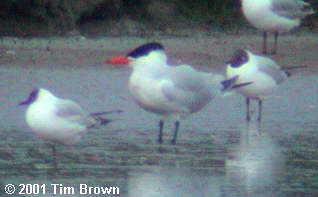 Coinciding
with a good passage of Fulmar five Manx
Shearwater flew south
past Corton/Lowestoft on the 2nd. The first sighting consisted of a group
of three followed by two singletons off Corton. On
the 3rd a single bird passed south at Ness Point and further down the coast
40 or so flew past Southwold. Of interest, 130+
passed Camperduinin, HOLLAND
on the 3rd.
Coinciding
with a good passage of Fulmar five Manx
Shearwater flew south
past Corton/Lowestoft on the 2nd. The first sighting consisted of a group
of three followed by two singletons off Corton. On
the 3rd a single bird passed south at Ness Point and further down the coast
40 or so flew past Southwold. Of interest, 130+
passed Camperduinin, HOLLAND
on the 3rd.
500 Common
Swift, Apus apus, that passed south at Corton on the evening
of the 27th were part of a feeding flock navigating thunderstorms. Such
groups will often travel large distances to avoid adverse weather systems.
An
unseasonal pair of Grey Wagtail, Motacilla cinerea, were seen
on rocks in Lowestoft Harbour on the 21st and
seven Common Crossbills, Loxia curvirostra, reported near
Lound on the 30th were presumably immigrants.
Surburban drama took place on the 5th
when
a male Blackbird,
Turdus merula,
foolishly tried to catch
a Common Newt Triturus vulgaris from a south Lowestoft garden
pond. The raid was thwarted by a bird club regular and
the newt was returned to the pond safely but was too shocked to comment.
Few
could disagree that the first half of the year has been good, lets just
hope the second half is a cracker!!!
Forward
to part 2 - July to December
The links below will take you to the individual news pages for the year 2001.